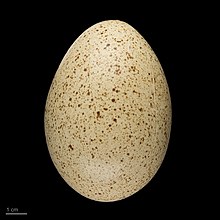
The common pheasant is a bird in the pheasant family (Phasianidae). The genus name comes from Latin phasianus, "pheasant". The species name colchicus is Latin for "of Colchis", a country on the Black Sea where pheasants became known to Europeans. Although Phasianus was previously thought to be closely related to the genus Gallus, the genus of junglefowl and domesticated chickens, recent studies show that they are in different subfamilies, having diverged over 20 million years ago.

The green pheasant, also known as the Japanese green pheasant, is an omnivorous bird native to the Japanese archipelago, to which it is endemic. Some taxonomic authorities consider it a subspecies of the common pheasant, Phasianus colchicus. It is the national bird of Japan.

The water pipit is a small passerine bird which breeds in the mountains of Southern Europe and the Palearctic eastwards to China. It is a short-distance migrant; many birds move to lower altitudes or wet open lowlands in winter.

The boreal owl or Tengmalm's owl is a small owl in the "true owl" family Strigidae. It is known as the boreal owl in North America and as Tengmalm's owl in Europe after Swedish naturalist Peter Gustaf Tengmalm or, more rarely, Richardson's owl after Sir John Richardson.
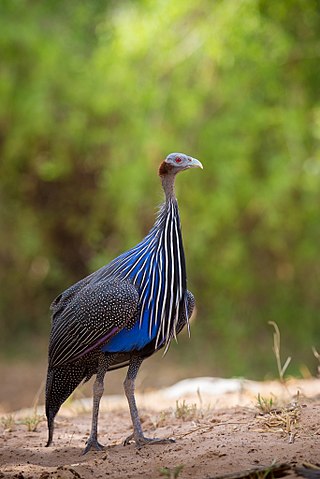
The vulturine guineafowl is the largest extant species of guineafowl. Systematically, it is only distantly related to other guineafowl genera. Its closest living relative, the white breasted guineafowl, Agelastes meleagrides inhabit primary forests in Central Africa. It is a member of the bird family Numididae, and is the only member of the genus Acryllium. It is a resident breeder in northeast Africa, from southern Ethiopia through Kenya and just into northern Tanzania.

The snowcocks or snowfowl are a group of bird species in the genus Tetraogallus of the pheasant family, Phasianidae. They are ground-nesting birds that breed in the mountain ranges of southern Eurasia from the Caucasus to the Himalayas and western China. Some of the species have been introduced into the United States. Snowcocks feed mainly on plant material.
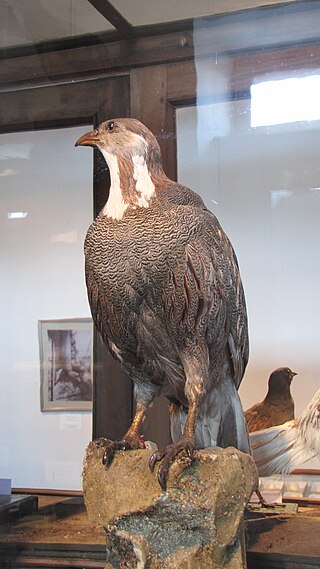
The Caspian snowcock is a snowcock in the pheasant family Phasianidae of the order Galliformes, gallinaceous birds.

The crested partridge also known as the crested wood partridge, roul-roul, red-crowned wood partridge, green wood quail or green wood partridge is a gamebird in the pheasant family Phasianidae of the order Galliformes, gallinaceous birds. It is the only member of the genus Rollulus.
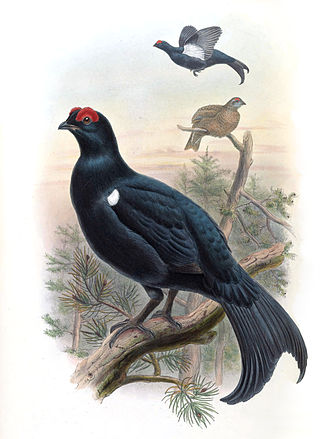
The Caucasian grouse or Caucasian black grouse is a large bird in the grouse family. It is closely related to the black grouse.

The silver pheasant is a species of pheasant found in forests, mainly in mountains, of mainland Southeast Asia and eastern and southern China, with an introduced population on Victoria Island in Nahuel Huapi Lake, Neuquén, Argentina. The male is black and white, while the female is mainly brown. Both sexes have a bare red face and red legs. It is common in aviculture, and overall also remains common in the wild, but some of its subspecies are rare and threatened.

The snow partridge is a gamebird in the pheasant family Phasianidae found widely distributed across the high-altitude Himalayan regions of Pakistan, China, India and Nepal. It is the only species within its genus, and is thought to be the most basal member of the "erectile clade" of the subfamily Phasianinae. The species is found in alpine pastures and open hillside above the treeline but not in as bare rocky terrain as the Himalayan snowcock and is not as wary as that species. Males and females look similar in plumage but males have a spur on their tarsus.
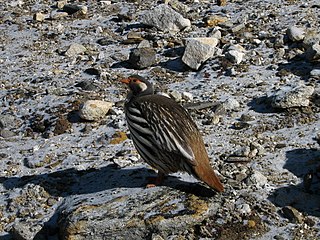
The Tibetan snowcock is a bird in the pheasant family Phasianidae of the order Galliformes, gallinaceous birds. This species is found in high-altitude regions of the Western Himalayas and the Tibetan Plateau, where it overlaps in part with the larger Himalayan snowcock. The head is greyish and there is a white crescent patch behind the eye and underside is white with black stripes. In flight the secondaries show a broad white trailing edge.

Reeves's pheasant is a large pheasant within the genus Syrmaticus. It is endemic to China. It is named after the British naturalist John Reeves, who first introduced live specimens to Europe in 1831.

The Himalayan snowcock is a snowcock in the pheasant family Phasianidae found across the Himalayan ranges and parts of the adjoining Pamir range of Asia. It is found on alpine pastures and on steep rocky cliffs where they will dive down the hill slopes to escape. It overlaps with the slightly smaller Tibetan snowcock in parts of its wide range. The populations from different areas show variations in the colouration and about five subspecies have been designated. They were introduced in the mountains of Nevada in the United States in the 1960s and a wild population has established in the Ruby Mountains.

Germain's peacock-pheasant is a pheasant that is endemic to Indochina. The name commemorates the French colonial army's veterinary surgeon Louis Rodolphe Germain.

The Caucasus mixed forests is a temperate broadleaf and mixed forests ecoregion in the Caucasus Mountains, as well as the adjacent Lesser Caucasus range and the eastern end of the Pontic Mountains.

The handsome spurfowl is a species of bird in the pheasant family Phasianidae. It is a large, up to 35 cm long, terrestrial forest bird with a dark reddish brown plumage, grey head, red bill and legs, brown iris, bare red orbital skin and rufous grey below. Both sexes are similar. The female is slightly smaller than male. The young has duller plumage.

The Altai snowcock is a species of bird in the family Phasianidae. It is found in western Mongolia and adjacent areas of China, Kazakhstan and Russia. Its natural habitat is boreal forests.

Perdicinae is a polyphyletic former subfamily of birds in the pheasant family, Phasianidae, regrouping the partridges, Old World quails, and francolins. Although this subfamily was considered monophyletic and separated from the pheasants, tragopans, junglefowls, and peafowls (Phasianinae) till the early 1990s, molecular phylogenies have shown that these two subfamilies actually constitute only one lineage. For example, some partridges are more closely affiliated to pheasants, whereas Old World quails and partridges from the Alectoris genus are closer to junglefowls. Due to this, the subfamily Perdicinae is no longer recognized by the International Ornithological Congress, with the species being split among 3 subfamilies.
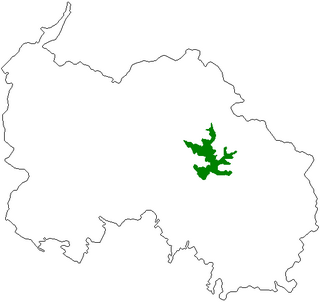
Liakhvi Strict Nature Reserve is a protected area in the historic region Shida Kartli on the southern slope of the Greater Caucasus range in the northeastern part of Tskhinvali District and in Akhalgori Municipality of Georgia. Reserve main goal is protecting flora and fauna in surrounding mountainous region. In general Patara Liakhvi gorge has many tourist attractions : ethnological, bird-watching and botanical.

